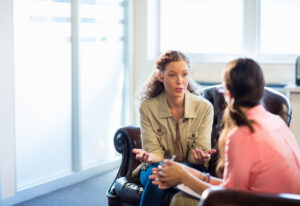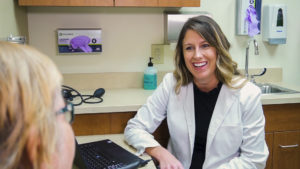It’s no secret that in medicine the cure can come at a cost. A medication that alleviates one problem may have unpleasant or adverse side effects. The surgery that mends an injury leads to a painful recovery period.
The COVID-19 pandemic is no different.
Social distancing is a necessary measure to slow the spread of the disease. And yet the isolation needed to avoid spreading the virus to others can exacerbate another problem: the so-called “Loneliness Epidemic.”
To start, let’s define “social distancing,” examine its benefits, and explore ways to offset its “side effects” when it comes to mental health and loneliness.
What Exactly Is Social Distancing?
The Centers for Disease Control and Prevention’s (CDC) definition of social distancing has two components: Maintain a distance of at least six feet from others and stay out of crowded places. State authorities have added further measures and clarity, such as avoiding groups of 10 or more people and issuing “shelter in place” or “stay at home” orders. To use Virginia as an example, this order means “individuals … shall remain at their place of residence” except for essential services, such as:
- Obtaining food, beverages, goods, or services
- Seeking medical attention, essential social services, governmental services, assistance from law enforcement, or emergency services
- Taking care of other individuals, animals, or visiting the home of a family member
- Traveling required by court order or to facilitate child custody, visitation, or child care
- Engaging in outdoor activity, including exercise, provided individuals comply with social distancing requirements
- Traveling to and from one’s residence, place of worship, work, or educational institution
- Volunteering with organizations that provide charitable or social services
- Leaving one’s residence due to a reasonable fear for health or safety, at the direction of law enforcement, or at the direction of another government agency
However, social distancing is not synonymous with self-quarantine or isolation. Johns Hopkins Medicine suggests individuals “who have been exposed to” or “art at risk for coming down with COVID-19 might practice self-quarantine.” Self-quarantine includes, but may not be limited to, practicing the following measures for 14 days:
- Using standard hygiene and washing hands frequently
- Not sharing things like towels and utensils
- Staying at home
- Not having visitors
- Staying at least six feet away from other people in your household
Then, there is isolation. Isolation involves “keeping people who are infected with a contagious illness away from those who are not infected.” This can take place either at home, a hospital, or a care facility. Furthermore, caretakers of isolated individuals are advised to use “special personal protective equipment.”
These are all proven ways to “flatten the curve,” or slow the spread of disease to avoid overwhelming medical resources. In the end, the same number of patients may contract the virus, but those who require critical care would be more likely to have access to a hospital bed and lifesaving respirators.
The Problem of Social Distancing
While we know that social distancing can help save lives, what we don’t know is how long the measure will remain in place. For instance, Virginia’s order lasts through June 10, and could extend further as needed. We simply do not know what the state of the pandemic will be in a week, much less a month or two. Models by researchers from the Harvard T.H. Chan School of Public Health suggest intermittent periods of social distancing should last through February 2021.
Regardless of the duration, we must acknowledge that social distancing will exacerbate another global public health problem, the “Loneliness Epidemic.”
A Cigna survey of more than 20,000 U.S. adults revealed some stark findings on the issue:
- Nearly half of Americans report sometimes or always feeling alone (46 percent) or left out (47 percent).
- One in four Americans (27 percent) rarely or never feel as though there are people who really understand them.
- Two in five Americans sometimes or always feel that their relationships are not meaningful (43 percent) and that they are isolated from others (43 percent).
The consequences are not limited to emotional distress or poor mental health. “Loneliness has been estimated to shorten a person’s life by 15 years, equivalent in impact to being obese or smoking 15 cigarettes per day,” Claire Pomeroy writes in Scientific American. “A recent study revealed a surprising association between loneliness and cancer mortality risk, pointing to the role loneliness plays in cancer’s course, including responsiveness to treatments.”
The effects are especially pronounced in elderly individuals, a group most encouraged to follow social distancing measures. According to the National Institute on Aging, “Research has linked social isolation and loneliness to higher risks for a variety of physical and mental conditions: high blood pressure, heart disease, obesity, a weakened immune system, anxiety, depression, cognitive decline, Alzheimer’s disease, and even death.”
Given that loneliness affects our physical health — and can even weaken our immune system making us more susceptible to COVID-19 — what can we do to lessen the effects of loneliness in ways that comply with social distancing measures and laws?
Social Distancing-Friendly Solutions to the Loneliness Epidemic
As part of their COVID-19 resources toolkit, the CDC has published a guide on how to manage stress and coping. First, be aware of the signs of stress:
- Fear and worry about your own health and the health of your loved ones
- Changes in sleep or eating patterns
- Difficulty sleeping or concentrating
- Worsening of chronic health problems
- Increased use of alcohol, tobacco, or other drugs
Once aware of the signs, consider the following activities to lessen the stress of the pandemic and social distancing:
- Take breaks from watching, reading, or listening to news stories, including social media. Hearing about the pandemic repeatedly can be upsetting.
- Take care of your body. Take deep breaths, stretch, or meditate. Try to eat healthy, well-balanced meals, exercise regularly, get plenty of sleep, and avoid alcohol and drugs.
- Make time to unwind. Try to do some other activities you enjoy.
- Connect with others. Talk with people you trust about your concerns and how you are feeling.
Technology can be a great tool for connecting with others and staying entertained. For instance, use your smartphone to video-chat a friend. Browse uplifting videos and content on social media. Try mindfulness and self-care apps, such as Sanvello and Headspace (which is currently free for healthcare providers), to calm feelings of anxiety and uncertainty. Break a sweat with online workout videos or even live group classes.
Social media also provides many opportunities to connect with friends and join online communities. For example, after watching a movie, you could engage with other fans on Letterboxd. Or after finishing a great book, write a review on Goodreads and discuss the book in a digital book club. However, also consider limiting screen time as some studies show overuse may negatively affect mental health and disrupt sleep patterns.
If you are concerned about your mental health, consider scheduling a telehealth visit with a therapist or psychiatrist. Domenica Favero, Psy.D., a psychologist and Privia provider, notes that telepsychology is effective and “clients continue to feel connected with their therapist even when in online settings.”
Finally, consider sharing the following hotlines for individuals experiencing a mental health crisis:
- Suicide Prevention Lifeline: 1.800.273.8255
- Substance Abuse and Mental Health Services Administration: 1.800.662.4357
- National Institute of Mental Health: 866.615.6464
- National Alliance on Mental Illness: 1.800.950.6264
In closing, make sure you follow state and federal guidelines for social distancing, but also explore new ways to make the most of the situation and stay connected with others. While we can’t say for sure if social distancing will exacerbate the Loneliness Epidemic, these tips and guidelines can hopefully reduce the impact and keep us safe.
















Very informative article, thank you